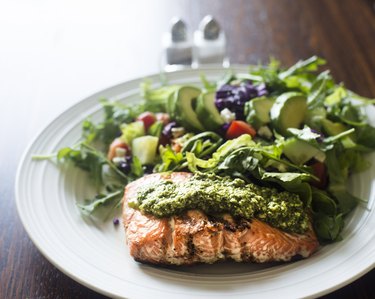
When you hear the word "diet," you may automatically think about weight loss. But there are plenty of diet plans out there that aim to do more than whittle down your waistline.
Whether your goal is to lower your cholesterol, reduce inflammation, counter GI ailments or support your brain health, research shows that eating the right foods can make a real difference.
In that spirit, we've broken down the most popular diets linked to specific health outcomes so you can be sure you have all the information you need. That said, always speak with your doctor before starting any diet plan, and especially before starting one that aims to manage a health condition.
The Mediterranean Diet: Eating for Longevity

Based on the traditional eating styles of countries lining the Mediterranean Sea (think: Greece, Spain, Italy), the Mediterranean diet has been touted for decades as effective in boosting heart health, and it may also reduce inflammation and help you lose weight.
Followers focus on vegetables, fruits, nuts and seeds, legumes and lean protein, and extra-virgin olive oil plays a starring role. Sweets and processed food are limited, but a nightly glass or two of wine is highly encouraged.
Check out five benefits of the Mediterranean diet, along with two potential drawbacks to know about.
The Low-FODMAP Diet: A Plan for Digestive Woes

Foods high in FODMAPs — that is, certain types of fermentable carbohydrates — often trigger or worsen the symptoms of irritable bowel syndrome (IBS), including gas, bloating, stomach pain, diarrhea or constipation. But researchers have found that sticking to a low-FODMAP diet can ease these common complaints, and the American College of Gastroenterology backs up the recommendation.
The tricky part? Many healthy foods — like a variety of fruits and vegetables — contain FODMAPs, so it's important to work with an expert to avoid any nutritional deficiencies.
Learn about the three phases of the low-FODMAP diet and a modified version called "FODMAP gentle."
The DASH Diet: Help for High Blood Pressure

The Dietary Approaches to Stop Hypertension (DASH) diet works to lower blood pressure by encouraging lower-sodium choices and amping up potassium-rich foods — a combination that has proven effective in study after study.
The diet is relatively easy to follow, healthy for just about everyone and has a few added benefits, including better blood sugar control and reduced cholesterol levels. It may even help some people lose a little weight.
See our primer on the DASH diet for the full breakdown on how it works and which foods are included.
The MIND Diet: Prioritize Brain-Boosting Foods

Tons of research supports the idea that certain foods can help keep us mentally sharp as we age. And the MIND diet, which combines elements of the Mediterranean and DASH diets, may even help fend off dementia and reduce the risk of Alzheimer's.
Followers of this diet plan eat lots of green leafy vegetables, berries, nuts and whole grains, while limiting red meat, butter, cheese, sweets and fried foods.
Get the details on the science behind the MIND diet, plus five easy steps that can help you get started.
The TLC Diet: A Plan That Combats Cholesterol

While our cholesterol numbers may not be entirely determined by the foods we eat (there's a genetic factor, after all), our diets do play an important role. That's why the National Institutes of Health created the Therapeutic Lifestyle Changes (TLC) diet. With its emphasis on heart-healthy foods and other key lifestyle modifications, the diet aims to help followers lower their total cholesterol and, as a result, reduce the risk of chronic conditions like heart disease.
As the name implies, the diet is meant to be a lifestyle shift and a sustainable plan people can follow for the long term.
Read up on the rules of the TLC diet, including recommended foods and physical activity guidelines.
Dr. Weil's Diet: Reducing Chronic Inflammation

Inflammation is more than just a buzzword you're seeing everywhere. Doctors and researchers are beginning to understand that chronic, low-grade inflammation — which may be caused by a variety of factors, including an unhealthy diet — is linked to diabetes, heart disease and cancer, among other conditions.
The good news is that there are ways to reduce the amount of inflammation in the body, and the anti-inflammatory diet, created by celebrity physician Andrew Weil, aims to do just that.
Here's what you should know about Dr. Weil's anti-inflammatory diet, such as how to choose the right foods and how to ease into this way of eating.
The Gluten-Free Diet: Crucial for People With Celiac Disease

While a gluten-free diet isn't the same as a low-carb eating plan like the keto diet, the two are often confused. But what exactly does a gluten-free approach look like, and who might benefit from it?
The short answer: A diet plan that nixes or severely limits gluten is for people with celiac disease or a sensitivity to gluten. And that's about it.
Get the details on what it means to go gluten-free and the benefits and drawbacks to note.